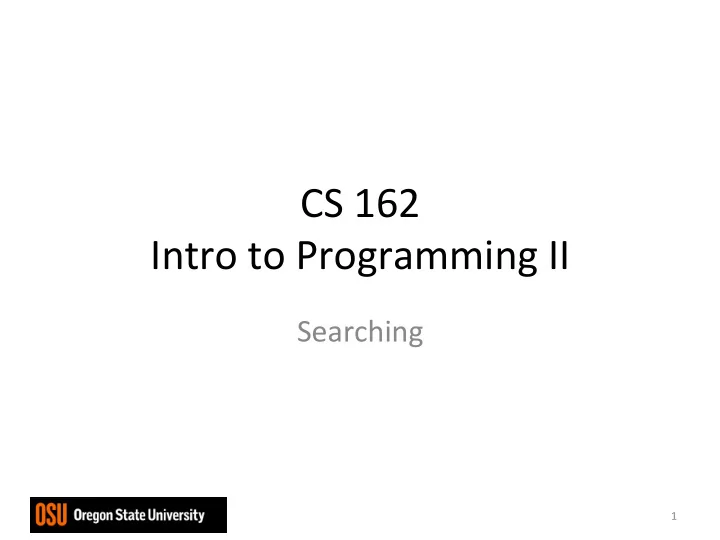

CS ¡162 ¡ Intro ¡to ¡Programming ¡II ¡ Searching ¡ 1 ¡
Searching ¡ • Data ¡is ¡stored ¡in ¡various ¡structures ¡ – Typically ¡it ¡is ¡organized ¡on ¡the ¡type ¡of ¡data ¡ – Op@mized ¡for ¡retrieval ¡of ¡informa@on ¡ • Searching ¡implies ¡that ¡items ¡can ¡be ¡compared ¡ • Ideal ¡search ¡algorithm ¡is ¡O(1) ¡ – Is ¡it ¡possible? ¡ 2 ¡
Searching ¡ • Usually ¡want ¡more ¡than ¡just ¡a ¡boolean ¡result ¡ • We ¡have ¡an ¡element ¡to ¡remove, ¡add ¡or ¡ update ¡ • If ¡the ¡item ¡is ¡found, ¡should ¡return ¡the ¡loca@on ¡ of ¡the ¡search ¡item ¡ • If ¡not ¡found, ¡should ¡return ¡loca@on ¡where ¡it ¡ belongs ¡(if ¡list ¡is ¡ordered) ¡ • How ¡should ¡duplicates ¡be ¡handled? ¡ 3 ¡
Linear ¡Search ¡ • Suppose ¡you ¡want ¡to ¡find ¡a ¡number ¡in ¡an ¡ unordered ¡sequence ¡ • You ¡have ¡no ¡choice ¡– ¡look ¡through ¡all ¡ elements ¡un@l ¡you ¡have ¡found ¡a ¡match ¡ • This ¡is ¡called ¡linear ¡or ¡sequen@al ¡search ¡ 5 ¡ ¡3 ¡ ¡2 ¡ ¡6 ¡ ¡4 ¡ ¡1 ¡ 3 ¡ 7 ¡ • Example: ¡find ¡the ¡number ¡4 ¡in ¡the ¡array ¡ 4 ¡
Complexity ¡ Best ¡Case-‑ ¡ ¡ ¡ target ¡in ¡first ¡loca@on ¡ ¡O(1) ¡ ¡ Worst ¡Case-‑ ¡ ¡ ¡ ¡ ¡ ¡ ¡ ¡ ¡O(n) ¡ Average ¡Case-‑ ¡ ¡ ¡ ¡ ¡ ¡ ¡O(n) ¡ ¡ ¡ ¡ ¡ ¡ Linear ¡search ¡is ¡an ¡O(n) ¡algorithm ¡ 5 ¡
Code ¡ ¡ int ¡search(int ¡a[], ¡int ¡size, ¡int ¡v) ¡ { ¡ for( ¡int ¡i ¡= ¡0; ¡i ¡< ¡size; ¡i++ ¡) ¡ { ¡ if( ¡a[i] ¡== ¡v ¡) ¡ return ¡i; ¡ } ¡ return ¡-‑1; ¡ } ¡ 6 ¡
Linear ¡Search ¡ • What ¡if ¡you ¡do ¡a ¡linear ¡search ¡on ¡a ¡sorted ¡array? ¡ 1 ¡ ¡2 ¡ ¡2 ¡ ¡3 ¡ ¡4 ¡ ¡5 ¡ 6 ¡ 7 ¡ • Not ¡much ¡changes ¡ – Best ¡case: ¡O(1) ¡ – Worst ¡case: ¡O(n) ¡ – Average ¡case: ¡O(n) ¡ • It’s ¡s@ll ¡O(n). ¡But ¡there ¡is ¡a ¡beger ¡search ¡ technique ¡called ¡binary ¡search! ¡ 7 ¡
Binary ¡Search ¡ • What ¡if ¡you’re ¡looking ¡for ¡15 ¡in ¡this ¡array: ¡ ¡ 1 ¡ ¡5 ¡ ¡8 ¡ ¡9 ¡ ¡12 ¡ ¡17 ¡ 20 ¡ 32 ¡ • We’ll ¡look ¡at ¡the ¡first ¡or ¡last ¡half. ¡ ¡ ¡ 1 ¡ ¡5 ¡ ¡8 ¡ 9 ¡ ¡12 ¡ ¡17 ¡ 20 ¡ 32 ¡ • The ¡number ¡in ¡the ¡middle ¡of ¡the ¡en@re ¡sorted ¡array ¡ is ¡9. ¡(Note: ¡ ¡we’ll ¡consider ¡the ¡middle ¡to ¡be ¡the ¡last ¡ number ¡in ¡the ¡first ¡half). ¡ • 9 ¡< ¡15, ¡so ¡15 ¡must ¡be ¡in ¡the ¡second ¡half. ¡We’ll ¡grey ¡ out ¡the ¡first ¡half ¡ 8 ¡
Binary ¡Search ¡ 1 ¡ ¡5 ¡ ¡8 ¡ ¡17 ¡ ¡12 ¡ ¡17 ¡ 20 ¡ 32 ¡ ¡ The ¡number ¡in ¡the ¡middle ¡of ¡the ¡right ¡half ¡is ¡17. ¡15 ¡< ¡17, ¡so ¡15 ¡ ¡ ¡ 1 ¡ ¡5 ¡ ¡8 ¡ ¡17 ¡ ¡12 ¡ ¡17 ¡ 20 ¡ 32 ¡ ¡ The ¡number ¡in ¡the ¡middle ¡of ¡the ¡lek ¡half ¡is ¡12. ¡12 ¡< ¡15, ¡so ¡15 ¡ must ¡be ¡in ¡the ¡right ¡half ¡(of ¡the ¡white ¡numbers) ¡ 9 ¡
Binary ¡Search ¡ 1 ¡ ¡5 ¡ ¡8 ¡ ¡17 ¡ ¡12 ¡ ¡17 ¡ 20 ¡ 32 ¡ • 17 ¡is ¡obviously ¡not ¡15. ¡So ¡15 ¡is ¡not ¡in ¡the ¡array. ¡ • However, ¡if ¡we ¡had ¡to ¡insert ¡15 ¡into ¡the ¡array, ¡we ¡ would ¡put ¡it ¡before ¡17 ¡at ¡index ¡5 ¡ • What ¡we ¡just ¡did ¡is ¡called ¡binary ¡search. ¡ ¡ – It’s ¡binary ¡because ¡we ¡cut ¡the ¡size ¡of ¡the ¡search ¡in ¡half ¡ at ¡each ¡step. ¡ ¡ – This ¡culng ¡in ¡half ¡only ¡works ¡because ¡the ¡array ¡is ¡ sorted! ¡ ¡ ¡ 10 ¡
Code ¡ int ¡search(int ¡a[], ¡int ¡size, ¡int ¡v) ¡{ ¡ int ¡low ¡= ¡0; ¡ int ¡high ¡= ¡size ¡– ¡1; ¡ while( ¡low ¡<= ¡high ¡) ¡{ ¡ int ¡mid ¡= ¡(low ¡+ ¡high)/2; ¡ int ¡diff ¡= ¡a[mid] ¡– ¡v; ¡ if( ¡diff ¡== ¡0 ¡) ¡// ¡a[mid] ¡== ¡v ¡ return ¡mid; ¡ else ¡if ¡(diff ¡< ¡0) ¡// ¡a[mid] ¡< ¡v ¡ low ¡= ¡mid ¡+ ¡1; ¡ else ¡ high ¡= ¡mid ¡– ¡1; ¡ } ¡ return ¡-‑1; ¡ } ¡ 11 ¡
Complexity ¡ ¡ The ¡size ¡of ¡the ¡search ¡space ¡is ¡reduced ¡by ¡2 ¡ every ¡itera@on ¡ ¡ That ¡makes ¡the ¡complexity ¡O(log ¡n) ¡ ¡ Best ¡Case-‑ ¡ ¡ ¡ ¡O(1) ¡ ¡ Worst ¡Case-‑ ¡ ¡ ¡O(log ¡n) ¡ Average ¡Case-‑ ¡ ¡ ¡ ¡O(log ¡n) ¡ ¡ ¡ 12 ¡
Choosing ¡a ¡Search ¡Method ¡ • Linear ¡search ¡is ¡O(n) ¡ • Binary ¡search ¡is ¡O(log ¡n) ¡ • Linear ¡search ¡is ¡easier ¡to ¡code ¡ • Binary ¡search ¡will ¡be ¡MUCH ¡faster ¡on ¡large ¡ data ¡ ¡ – But ¡the ¡data ¡must ¡be ¡sorted ¡first ¡ 13 ¡
Tradeoff ¡ Is ¡it ¡faster ¡to: ¡ a) ¡Sort ¡an ¡array ¡first ¡then ¡use ¡binary ¡search ¡OR ¡ b) ¡Do ¡a ¡linear ¡search ¡on ¡the ¡unsorted ¡array? ¡ ¡ It ¡depends… ¡ If ¡you ¡search ¡only ¡once, ¡then ¡it’s ¡beger ¡to ¡do ¡a ¡linear ¡search, ¡ which ¡is ¡O(n) ¡ ¡ ¡ ¡If ¡you ¡search ¡many ¡@mes, ¡then ¡it’s ¡beger ¡to ¡pay ¡the ¡price ¡of ¡ sor@ng, ¡which ¡is ¡O(n ¡log(n)) ¡then ¡do ¡as ¡many ¡O(log(n)) ¡binary ¡ searches ¡as ¡you ¡have ¡to ¡do ¡ 14 ¡
Recommend
More recommend